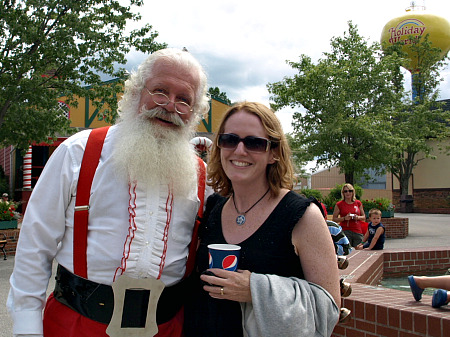
We already knew that Disneyland also saw an attendance increase this year, fueled in large part by free birthday admissions and other promotions. SeaWorld also announced this week that its Orlando park had a "very, very strong performance" due to the debut of its Theme Park Insider Award-winning Manta roller coaster and aquarium.
Which got me thinking, how did these three parks manage to increase attendance when so many others welcomed fewer visitors this year? What do these three parks have in common?
Why, of course: They all were on this year's Theme Park Insider Summer Roadtrip!
Nah, that couldn't be mere coincidence. Obviously, the simple inclusion of these parks on the roadtrip itinerary pushed them to succeed while the rest of the industry failed. Therefore, theme parks are now welcomed to e-mail me their bids to be included in my 2010 roadtrip, as a hedge against what looks like another lousy year for the economy.
(I would suggest taking a moment now to wipe the dripping sarcasm from your computer screen.)
I'm sure that TPI readers have, uh, better theories on why some parks did well this year, as others tanked. Let's hear 'em in the comments.
Tweet
When it comes to the economy and it's effect on parks, a bad economy separates the men from the boys when it comes to many businesses, and that includes the regional park market. I think that most of the good regional amusement parks (Busch Gardens Europe, Cedar Point, Kings Island, a couple Six Flags parks...etc) probably at least broke even in the attendance dept. They are good products, and they are highly popular in their respective markets. The fact that most of them are inexpensive alternatives to big vacations that many people didn't take this year didn't hurt either.
My theory on people is this. Even in a down economy, people, regardless of their income, who want something enough can usually find the money for it somewhere...be it cash or be it credit. A good popular product will still sell in a down economy if it's the right price. In Disney World's case, it wasn't the right price. A family trip to Disney in Orlando runs into the thousands of dollars, while a family or 4 can enjoy the regional amusement park for a few hundred. Disney had to sacrifice the bottom line for their attendance, so I can't really call Disney's season a "success" when compared with a park like Holiday World, who operated business as usual this year. Disney was successful in avoiding disaster, but they weren't built for tough economic times, and they were set back a little because of the heavy discounting. Holiday World had the same discounts and marketing they always had and the same admission price, and they broke their own attendance record.
I'll be curious to see the Cedar Fair and Six Flags numbers at the end of the year. I think that the fans of the good regional parks still bought their season passes, and the annual one day visitors still came...possibly even for more than one day this year. There were probably some bad years and also some real dumpster fires, but I think that we are going to see a lot of flat numbers this year, which I suppose is some kind of success these days.
Also, I think parks looked more on improving what they do best rather than trying to expand into new grounds or rides.
The park design maintained many large trees, so it's shady unlike the concrete jungles. There is a nursing room for breastfeeding moms that is immaculate, air conditioned, and cheerful. It has a about a dozen glider rockers, two changing stations, clean towels, and a kitchen-sized sink. Most placed would put in benches or standard waiting room chairs (at best). The ability to leave the park or water park (it's conveniently located between both) and feed and change my baby in privacy and comfort made my day marvelous, so good that my family returned two more times during the summer.
This article has been archived and is no longer accepting comments.
Marketing and promotions has been make or break this year. Disney have kept attendance up through offering huge discounts on certain products, especially resort stay over at Walt Disney World. While this does keep attendance high it's not going to be great for profit margins and I'd imagine many parks report record-high attendances this year may in fact have still performed pretty poor financially.
My other theory is that many parks that we are seeing with higher attendances are regional parks that's main customer base is local customers. Holiday World is a prime example. More and more people will be flocking to local tourist attractions to get their entertainment fix this year rather than going on vacation. This ultimately works out well for the regional parks whilst the parks that rely on international customer suffer.